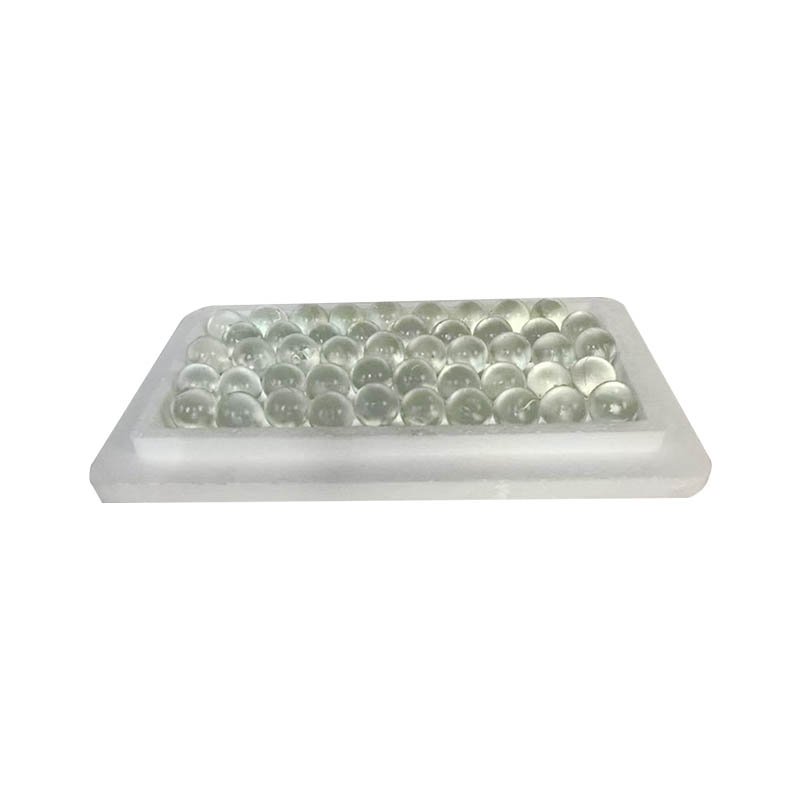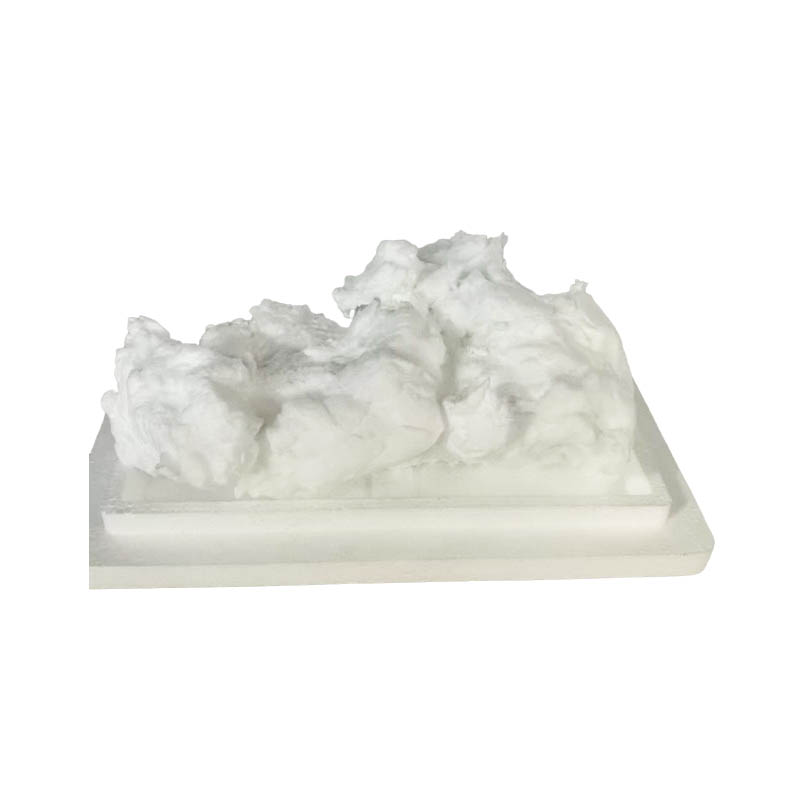Are the glass balls' particle size and shape highly uniform?
Release Time : 2025-10-04
In the field of high-end glass fiber manufacturing, especially the production of glass microfibers for air filter paper, the quality of the raw materials directly determines the performance and consistency of the final product. As the starting material for the melt drawing process, the physical form of glass balls—particularly the uniformity of particle size and shape—plays a crucial role in the fiber formation process. Whether drawing is done using the crucible or tank furnace method, the feeding process of the glass balls must be highly stable. Any fluctuation can cause uneven melting, flow fluctuations, or fiber breakage, which in turn affects the fiber's diameter consistency, surface quality, and yield. Therefore, the highly uniform particle size and shape of glass balls is a key indicator of their suitability for high-end microfiber manufacturing.
During the drawing process, glass balls are completely melted in a high-temperature crucible or furnace and then drawn into extremely fine continuous fibers through a precision nozzle. This process places extremely stringent demands on the uniformity of the raw material feed. If the glass balls vary significantly in size, small ones will melt first, while larger ones will lag behind. This leads to uneven melt composition and temperature distribution, compromising fiber drawing stability. Furthermore, irregularly shaped glass balls are prone to jamming, bridging, or poor flow during conveying, causing feed rate fluctuations, which in turn lead to varying drawing tensions, resulting in uneven fiber thickness and even breakage. Highly uniform spherical particles, on the other hand, flow freely and smoothly through the feeding system, ensuring that each glass ball enters the melt zone under identical conditions, thus maintaining a stable supply of melt.
The uniform particle size and regular spherical shape not only improve feeding controllability but also optimize melting efficiency. Spherical particles have a minimal surface-to-volume ratio, resulting in more uniform heating, enabling rapid and consistent melting, and reducing localized overheating and the generation of unmelted residue. This uniform melt provides pure, stable glass melt for the subsequent drawing process, laying the foundation for the formation of ultrafine, continuous, and defect-free microfibers. For the submicron glass fibers required for air filter paper, any minor process disturbance can disrupt the fine fiber structure, affecting the pore distribution and filtration performance of the filter media. Therefore, raw material uniformity is a prerequisite for ensuring high filtration efficiency, low air resistance, and high dust holding capacity in the final filter paper.
Furthermore, the morphological consistency of glass balls directly impacts the operational stability and maintenance cycle of production equipment. In automated continuous production lines, a smooth feeding system is crucial for ensuring high productivity. Uniform spherical particles reduce equipment blockage, wear, and frequent downtime for cleaning, improving production efficiency and system reliability. Furthermore, a stable feed rate reduces the need for dynamic compensation in furnace temperature control and drawing tension adjustment, making the entire process easier to monitor and optimize, and facilitating consistent quality in mass production.
From a materials science perspective, the uniformity of glass balls also reflects the advanced manufacturing process. High-quality glass balls are typically produced through precision melt spraying or centrifugal pelletizing techniques, ensuring that each sphere maintains a perfect spherical shape and consistent dimensions during the cooling and solidification process. This process control is not only reflected in the appearance, but also goes deeper into the internal structure, ensuring density and uniformity of composition, thereby avoiding melting anomalies caused by internal stress or impurity accumulation. This source of quality control provides a reliable material foundation for downstream fiber manufacturing.
In the air filtration field, especially in the application of high-efficiency filter media such as HEPA and ULPA, the uniformity of glass microfibers is extremely demanding. The filtration mechanism of filter paper relies on the three-dimensional network structure formed by the fibers. The pore size distribution, fiber spacing, and interweaving density directly determine the particle interception efficiency. Uneven fiber thickness or defects such as broken fibers and nodules will cause local airflow short-circuits or abnormal pressure differences, reducing overall filtration performance. The source of all this is the quality of the glass balls. Only by achieving high uniformity in particle size and shape from the raw material end can the final filter media ensure highly consistent structural characteristics at the microscale, meeting the extremely demanding air quality requirements of highly sensitive environments such as medical, semiconductor, and nuclear power plants.
In summary, the uniformity of glass ball size and shape not only determines smooth feeding and flow control but also serves as the cornerstone for determining glass microfiber quality and filter material performance. It reflects the quality control capabilities of the entire supply chain, from raw materials to end products, and plays an indispensable "invisible pillar" role in the development of high-end air filtration technology.
During the drawing process, glass balls are completely melted in a high-temperature crucible or furnace and then drawn into extremely fine continuous fibers through a precision nozzle. This process places extremely stringent demands on the uniformity of the raw material feed. If the glass balls vary significantly in size, small ones will melt first, while larger ones will lag behind. This leads to uneven melt composition and temperature distribution, compromising fiber drawing stability. Furthermore, irregularly shaped glass balls are prone to jamming, bridging, or poor flow during conveying, causing feed rate fluctuations, which in turn lead to varying drawing tensions, resulting in uneven fiber thickness and even breakage. Highly uniform spherical particles, on the other hand, flow freely and smoothly through the feeding system, ensuring that each glass ball enters the melt zone under identical conditions, thus maintaining a stable supply of melt.
The uniform particle size and regular spherical shape not only improve feeding controllability but also optimize melting efficiency. Spherical particles have a minimal surface-to-volume ratio, resulting in more uniform heating, enabling rapid and consistent melting, and reducing localized overheating and the generation of unmelted residue. This uniform melt provides pure, stable glass melt for the subsequent drawing process, laying the foundation for the formation of ultrafine, continuous, and defect-free microfibers. For the submicron glass fibers required for air filter paper, any minor process disturbance can disrupt the fine fiber structure, affecting the pore distribution and filtration performance of the filter media. Therefore, raw material uniformity is a prerequisite for ensuring high filtration efficiency, low air resistance, and high dust holding capacity in the final filter paper.
Furthermore, the morphological consistency of glass balls directly impacts the operational stability and maintenance cycle of production equipment. In automated continuous production lines, a smooth feeding system is crucial for ensuring high productivity. Uniform spherical particles reduce equipment blockage, wear, and frequent downtime for cleaning, improving production efficiency and system reliability. Furthermore, a stable feed rate reduces the need for dynamic compensation in furnace temperature control and drawing tension adjustment, making the entire process easier to monitor and optimize, and facilitating consistent quality in mass production.
From a materials science perspective, the uniformity of glass balls also reflects the advanced manufacturing process. High-quality glass balls are typically produced through precision melt spraying or centrifugal pelletizing techniques, ensuring that each sphere maintains a perfect spherical shape and consistent dimensions during the cooling and solidification process. This process control is not only reflected in the appearance, but also goes deeper into the internal structure, ensuring density and uniformity of composition, thereby avoiding melting anomalies caused by internal stress or impurity accumulation. This source of quality control provides a reliable material foundation for downstream fiber manufacturing.
In the air filtration field, especially in the application of high-efficiency filter media such as HEPA and ULPA, the uniformity of glass microfibers is extremely demanding. The filtration mechanism of filter paper relies on the three-dimensional network structure formed by the fibers. The pore size distribution, fiber spacing, and interweaving density directly determine the particle interception efficiency. Uneven fiber thickness or defects such as broken fibers and nodules will cause local airflow short-circuits or abnormal pressure differences, reducing overall filtration performance. The source of all this is the quality of the glass balls. Only by achieving high uniformity in particle size and shape from the raw material end can the final filter media ensure highly consistent structural characteristics at the microscale, meeting the extremely demanding air quality requirements of highly sensitive environments such as medical, semiconductor, and nuclear power plants.
In summary, the uniformity of glass ball size and shape not only determines smooth feeding and flow control but also serves as the cornerstone for determining glass microfiber quality and filter material performance. It reflects the quality control capabilities of the entire supply chain, from raw materials to end products, and plays an indispensable "invisible pillar" role in the development of high-end air filtration technology.






